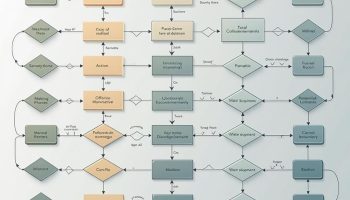Organizing communication with employees is crucial to the success of any strategic plan. They need to understand what you want them to do in order for your company’s goals to be met. If communication is not done effectively, then it may cause employee dissatisfaction and lead to decreased productivity.
In order to communicate your strategic plan to employees, you need a communication strategy. You’ve to develop an awesome strategic plan for your company.
How do you go about creating one? Here, we will give some great communication strategies for communicating your strategic plan to employees. We will also cover some communication tips for improving communication at work and how it can affect productivity.
What is the Strategic Communication Plan?
The communication plan is a document that outlines how your company plans to communicate with the internal staff members. It’s critical for all companies, especially those who are dedicated to achieving their strategic goals.
A communication strategy includes information on why communication is important and what actions need to be taken in order to achieve it effectively at work. It also includes; communication channels, communication objectives, and communication messages.
Communication Channels: This includes the different channels that you will use. There are various options for this such as – face-to-face meetings or roundtables for employees to ask questions.
Communication Objectives: This includes objectives that you need to meet before you start communicating with employees about your strategic plan. Once these communication objectives are set and you achieve them. Then, you will know it is time to communicate with them.
Communication Message: The message defines exactly what needs to happen after employees receive information within an organization regarding its strategic plans. They must understand why these changes are happening and how it affects them.
Benefits of communicating your strategic plan:
There are many benefits of communicating your strategic plan to employees. They include:
Employees feel engaged in the process, which leads to better job satisfaction among them. This means they will be more willing to complete the tasks assigned to them
Hence communication can go viral within an organization if done correctly. Overall, communication is key when trying to achieve any goal that has been set before you whether personal or professional goals.
The most important thing here is knowing how both parties feel about this communication process since there should be a mutual understanding.
Common objectives for Strategic Plan:
Here are the common communication objectives a company has when communicating the strategic plan with employees:
- The communication needs to be clear and concise.
- They need to know what the company is trying to accomplish.
- Tell them about their role is in achieving your company’s goals.
- Give them a clear explanation of how their role fits into the plan.
- Don’t just tell people what they must do, but also ask them for feedback.
Key components of a strategic plan:
When it comes to communicating your message, the “W5” approach is useful for framing what you want people on both sides of an issue or conversation to understand.
This starts by determining;
Who: It refers to everyone who will involve in communication about your strategic plan. It can be people within your own company or even a communicator. This should include the people who have a stake in communication – they will either benefit or suffer from communication.
Why and What: What is the subject of communication and why it’s important. The purpose of communication should be to spread the message of why communication is important.
When: Communication should go with a timeline if possible. This can include deadlines for communication tasks, such as training employees on new workplace procedures or communication milestones. This is where you communicate again about your progress with communication strategies until you achieve all objectives.
Where and How: You should do the communication in a suitable location where the communicator can have access to employees. It’s also important to use communication channels that are available for the message you want to convey.
Challenges teams face while understanding your strategic plan:
When you communicate with employees about your communication plan, there are some challenges people will face. Those who have a stake in communication need to understand what the organization is trying to accomplish. This includes communication objectives and business goals.
People also need to understand the communication message that you are trying to spread within your organization before they can react accordingly. Employees should know what role they play in achieving these communication objectives, so don’t forget about them.
Here are some challenges teams will face while understanding your strategic plan;
No interaction with the business strategy:
Employees may not understand where communication fits into the business strategy. They may not understand communication’s impact on the organization. Most communication objectives are set within communication strategy, which must be met to communicate the strategic plan.
Employees may believe that communication is not necessary or doesn’t impact them in any way. Because they don’t understand its role in business communication. They should know how communication can help achieve other communication goals and objectives for your company.
Here are some ways to get their intersection:
Understand that communication is a process and not an event. It’s important to build communication skills within your organization. So they can complete the objectives set out in the communication strategy.
It’s also important to understand why employees need information before giving it to them. Otherwise, they will never respond positively or even react at all about communication strategies.
They must know what you communicate and how you expect them to communicate back with you. Along with their ideas for the improvement of future communication plans as well as current ones.
No connection to the business strategy:
If communication doesn’t link to business strategy, employees may feel isolated from the company. This can lead them to think communication strategies are a waste of time. If they don’t understand why communication is important to the organization or its future.
They also may believe that communication does not impact their work. Therefore it’s unnecessary for them to pay attention when objectives arise. But communication should still go with a strategy to help employees understand their role in communication for the organization.
Here is how you can make their connection with the strategy:
Communication should be a process, not an event. You should build communication skills within your organization. So they can complete the objectives set out in the strategy.
It’s also important for employees to understand why communication is necessary and how it impacts their work as well as other departments. They should know what role they play in achieving these communication goals, so don’t forget about them.
No link between current and future strategy:
When communication doesn’t link to current or future strategy, employees may feel as if they are being left out of the loop. They should learn how communication will drive organizational change and achieve business goals
So it’s unnecessary for them to pay attention when objectives arise. Communication strategies should adapt into a plan which includes communication channels and messages.
Here’s what you can do to make their link with the strategy:
Ask them what they think about your business strategy. What impact will it have?
Asking for their input gives you the chance to reword any communication that might be unclear or incorrect in terms of employee understanding. It also makes employees feel included in strategic planning which is important!
Employees are more likely to stay engaged and work harder when they understand why certain projects are being implemented. So gaining their trust with clear communication is key.






